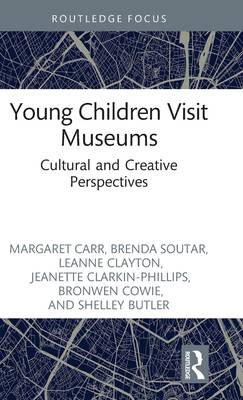
- Afhalen na 1 uur in een winkel met voorraad
- Gratis thuislevering in België vanaf € 30
- Ruim aanbod met 7 miljoen producten
- Afhalen na 1 uur in een winkel met voorraad
- Gratis thuislevering in België vanaf € 30
- Ruim aanbod met 7 miljoen producten
Young Children Visit Museums
Cultural and Creative Perspectives
Margaret Carr, Brenda Soutar, Leanne Clayton, Bronwen Cowie, Jeanette Clarkin-Phillips, Shelley ButlerOmschrijving
Bringing different cultural perspectives on creativity with them, teachers and children in two early childhood education sites in Aotearoa New Zealand were using museum visits as jumping off places to hone their creative capacity building.
As a contribution to Tim Ingold's discussion of anthropology and/as education, and also finding John Dewey's writing valuable (specifically his framing of 'enduring attitudes'), the authors employ a navigation metaphor throughout the discussion. They describe a coming together of four Cultural Anchors (thinking from materials) with four Coordinates (creative capacity builders) to describe ways in which the children were making creative sense of the museum exhibits, while at the same time gathering information about them. They take these travel metaphors from a star cluster in the southern hemisphere night sky, Matariki, which provided early sea-going Māori with guidance as they navigated wide stretches of ocean in their sea-going canoes to reach Aotearoa New Zealand.
A Māori immersion early childhood centre and school, and a New Zealand kindergarten provided lively examples of children's and teachers' responses to the treasured artefacts (taonga) in their local museums. The book describes an ecosocial framing, from 'little to big', and illustrates the different cultural perspectives on creativity. The Mana Tamariki kaiako (teachers) gifted us a title--He taonga, he rerenga arorangi (Where there are treasured objects, the spirit is nurtured and creativity will be inspired).
Specificaties
Betrokkenen
- Auteur(s):
- Uitgeverij:
Inhoud
- Aantal bladzijden:
- 110
- Taal:
- Engels
- Reeks:
Eigenschappen
- Productcode (EAN):
- 9781032078427
- Verschijningsdatum:
- 6/09/2022
- Uitvoering:
- Hardcover
- Formaat:
- Genaaid
- Afmetingen:
- 140 mm x 216 mm
- Gewicht:
- 290 g

Alleen bij Standaard Boekhandel
Beoordelingen
We publiceren alleen reviews die voldoen aan de voorwaarden voor reviews. Bekijk onze voorwaarden voor reviews.









